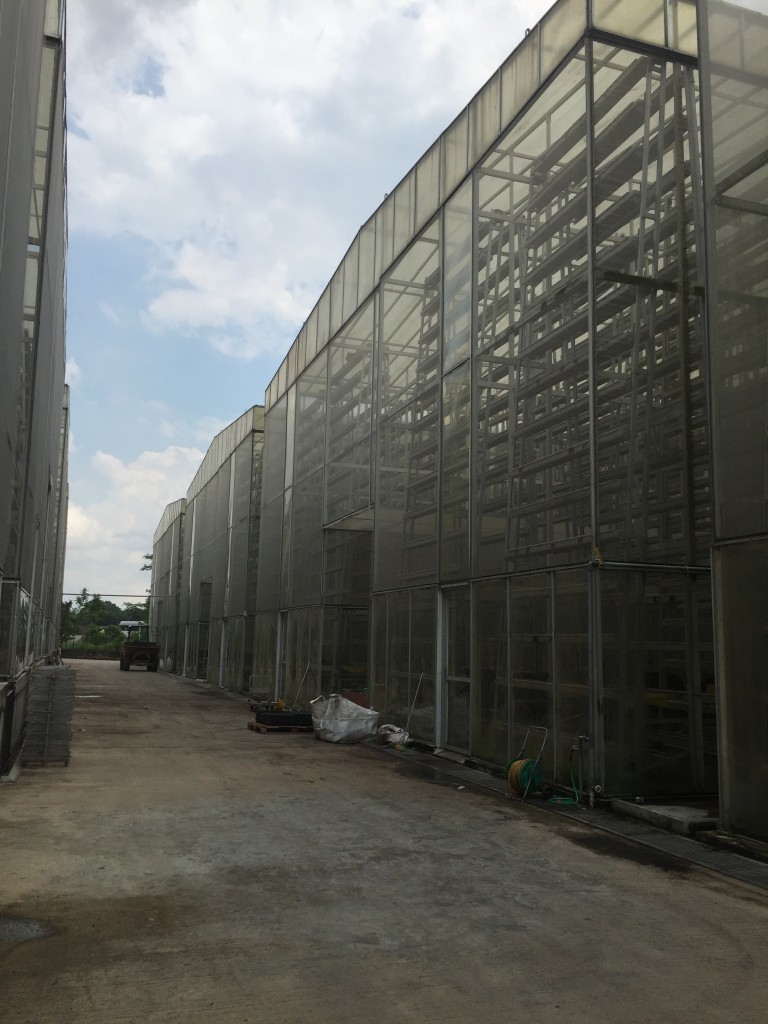Hey there!
If horizontal does not work, go vertical. A simple idea yet it is the main concept behind vertical farming which has become increasingly popular due to the lack of land space.
Last Wednesday, our batch (Environmental Studies Year 1 Students) went to Sky Greens as part of our learning journey. Sky greens is the ‘world’s first low carbon, hydraulic driven vertical farm’ which promotes farming with green methods (Sky Greens, 2014). The farm consists of rows of tall greenhouses. In each greenhouse, there are about 16 towers as high as 9 metres, each with 38 tiers of rotating growing toughs filled with vegetables.
Row of Greenhouses (Photo taken by Johanah Seow)
Photo Courtesy of Sky Greens (Growing troughs of vegetables)
It is really fascinating how they maximise the use of resources. One example is water. According to Sky Greens, only 12 litres of water is used per kilogram of vegetables. This is because rainwater is collected and used for watering through the water pipes. The excess water that is not absorbed by the vegetables is returned back to the pipes where it can be reused to water the vegetables again for up to 3-5 cycles. Water pressure is also used as hydraulic energy to rotate the toughs, reducing a significant amount of electricity.
Cai Xin harvested at the end of the tour which is purplish compared to the cai xin we usually see
Only 0.5% of Singapore’s land is allocated for agricultural purposes (Commonwealth network, 2013). With such limited land available, vertical farms is indeed an ingenious idea. Such feature not only maximises the use of space, the incorporation of these farms into our urban environment can also make farming more accessible which can make the industry more prominent. It is interesting that farming is no longer limited to land with soil. Sky greens has plans to place these greenhouses in rooftops or even integrate vertical farms into building facades or interior walls. These greenhouses can even be placed afloat on water (just like the Marina Bay Floating Platform), reflecting that the location of the greenhouses can be extended beyond solid ground. It has come to a point where farming can be done everywhere, even within the concrete walls where we work and live.
“It’s sad when you ask children where vegetables come from, and they say NTUC, or when you ask them where chickens come from and they say the fridge.”
Ms Chai Sheau Shi of organic vegetable farm Fire Flies
I feel that the quote above is something that we can all think about. I believe that the inclusion of farms into our urban living can allow us to gain a better understanding of our food sources. Farming may not be an major contributor to our economy but according to a quail farmer William Ho, farms can prove to be helpful in times of emergencies like SARS and bird flu (Ong, 2016). Therefore, I hope that more local farms can be promoted and treasured. In my next post, I will be discussing about the problems associated with vertical farming. Stay tuned!
Cheers!
♣ Johanah
References:
Sky Greens, (2014), About Sky Greens, Retrieved on 1 September 2016 from: http://www.skygreens.com/about-skygreens/
Commonwealth of Nations, (n.d), Find Agriculture Expertise in Singapore, Retrieved on 1 September 2016 from: http://www.commonwealthofnations.org/sectors-singapore/business/agriculture/
Ong, J, (2016 May 28), Unanswered Questions, Uncertain Future for Krani Farmers, Retrieved on 2 September 2016 from: http://www.channelnewsasia.com/news/singapore/unanswered-questions/2823076.html



No Comments